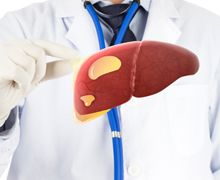
Aerobic exercise has been show effective in terms of removing liver fat from people suffering from non-alcoholic fatty liver disease (NAFLD). But the amount of time it takes to exercise can be a drawback. New research from Australia shows those pressed for time can make more progress in reversing this condition in less time by incorporating high-intensity interval training (HIIT).
NAFLD is a byproduct of rising obesity rates around the world and affects between 20-30 percent of the adult population. That makes it one of the most prevalent liver diseases. It is characterized by excess fat accumulation in the liver of people who do not drink alcohol extensively and can lead to serious health problems, including cirrhosis and liver cancer.
Losing weight and exercise are the primary interventions in the management of NAFLD. Researchers from Western Sydney University, the University of Sydney and the University of Queensland combined to look at the effect of exercise on liver fat. They their findings in The Journal of Clinical Endocrinology and Metabolism in a report titled, The Effect of High-intensity Interval Training vs Moderate-intensity Continuous Training on Liver Fat: A Systematic Review and Meta-Analysis is the first review to determine the effect of aerobic exercise on liver fat by comparing HIIT to MICT.
Researchers screened more than 28,000 studies and narrowed their focus to 19 studies that aligned closest to their focus. They assessed liver fat by non-invasive measurement techniques called proton magnetic resonance spectroscopy (H-MRS) and magnetic resonance imaging (MRI). Those are considered the gold standard in terms of non-invasive measurement.
They found both HIIT and MICT produced clinically significant liver fat reduction compared to the control (-2.85% for HIIT vs Control and -3.144% MICT vs Control). But HIIT, which involves a series of successive short bursts of exercise followed by periods of rest, takes up less time and energy.
"Non-alcoholic fatty liver disease is a predictor of metabolic disorders, closely linked to the development and severity of various diseases such as type 2 diabetes," said lead study author Dr. Angelo Sabag. "Our review demonstrates the importance of regular aerobic exercise as an effective therapy in those at risk, with both HIIT and MICT found to improve liver fat to similar degrees."
Dr. Sabag went on to say, "It is useful information to know that by training harder in less time with HIIT, you can achieve the same results as MICT, which is ideal for those with a busy lifestyle and little time," he said. "Another interesting finding was that even if people didn't exercise at volumes sufficient to satisfy the recommended physical activity guidelines, they could still achieve clinically significant improvements in liver fat so long as they exercised regularly above a moderate intensity."
Click here to read more in The Journal of Clinical Endocrinology & Metabolism.
